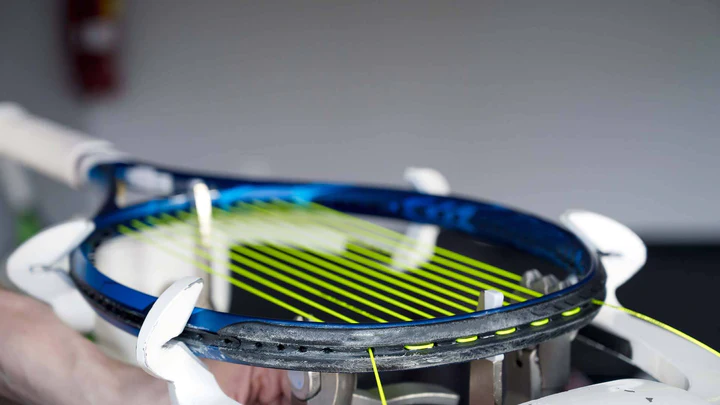String Symphony: Crafting the Perfect Harmony for Your Tennis Racket

Tennis, often referred to as the sport of kings, is a game where every aspect of equipment matters. From the weight of the racket to the grip size, every detail can make a significant difference in a player’s performance. Among these elements, perhaps one of the most crucial yet underrated components is the tennis string.
In the pursuit of mastering this beautiful game, players often overlook the importance of selecting the right strings for their racket. However, understanding the intricacies of tennis strings can unlock a world of performance enhancement and customization tailored to individual playing styles.
The Anatomy of Tennis Strings
Before delving into the realm of customization and performance enhancement, it’s essential to understand the basic anatomy of tennis strings. Tennis strings are typically made from materials such as nylon, polyester, natural gut, or a combination of these materials. Each material offers unique characteristics that influence factors such as durability, spin potential, and feel.
Nylon Strings
Nylon strings are widely popular among recreational players for their affordability and durability. They provide decent power and control, making them suitable for players looking for a versatile string option.
Polyester Strings
Polyester strings, also known as “poly” strings, are favored by professional players for their exceptional control and spin potential. These strings offer excellent durability and retain tension well, making them suitable for aggressive baseline players who generate a lot of racket head speed.
Natural Gut Strings
Natural gut strings, derived from the intestines of cows, offer unmatched feel and comfort. They provide excellent power and control while minimizing shock and vibration. Although natural gut strings are the most expensive option, many players swear by their unparalleled performance.
Customization: Tailoring Strings to Your Game
Just as every player has a unique playing style, their choice of tennis strings should also reflect individual preferences and requirements. Customization allows players to fine-tune their racket setup to optimize performance and comfort on the court.
Tension
The tension of tennis strings plays a crucial role in determining the racket’s power, control, and feel. Higher tension results in increased control and precision but sacrifices power and comfort. Conversely, lower tension offers more power and comfort but may compromise control. Finding the ideal tension for your playing style is essential for maximizing performance.
String Gauge
String gauge refers to the thickness of the tennis strings, typically measured in millimeters or gauges. Thicker strings provide durability and control but sacrifice spin potential and feel. On the other hand, thinner strings offer enhanced spin potential and feel but may break more easily. Selecting the appropriate string gauge depends on factors such as playing style, skill level, and desired performance characteristics.
String Pattern
The string pattern of a tennis racket refers to the arrangement of strings on the racket’s head. Rackets with denser string patterns offer better control and durability but may sacrifice power and spin. Conversely, rackets with more open string patterns provide increased power and spin potential at the expense of control. Choosing the right string pattern can significantly impact your playing experience and overall performance.
Innovations in Tennis String Technology
The world of tennis string technology is constantly evolving, with manufacturers continuously introducing innovations to enhance performance and meet the demands of modern players. From advanced materials to proprietary manufacturing processes, these innovations push the boundaries of what’s possible on the tennis court.
Multifilament Strings
Multifilament strings are constructed using multiple strands of synthetic materials bundled together. These strings mimic the feel and playability of natural gut while offering increased durability and consistency. Multifilament strings are an excellent choice for players seeking a balance of comfort, power, and control.
Co-Polyester Strings
Co-polyester strings combine polyester with other materials to improve playability and comfort. These strings offer exceptional control and spin potential while maintaining durability and tension stability. Co-polyester strings are popular among professional players for their ability to generate massive amounts of spin and control the ball effectively.
Textured Strings
Textured strings feature surface enhancements such as ridges or grooves designed to increase friction and spin potential. These strings allow players to impart more spin on the ball, making it easier to control trajectory and placement. Textured strings are especially beneficial for players who rely on spin-heavy shots to dictate play.
Conclusion
In the intricate tapestry of tennis equipment, strings serve as the vital thread that connects player to racket, power to control, and precision to spin. Understanding the nuances of tennis strings and customizing them to suit your playing style can elevate your game to new heights.
Whether you’re a recreational player looking to enhance comfort and power or a professional seeking the ultimate in control and spin, there’s a perfect string setup waiting to be discovered. By embracing the art of string customization and staying informed about the latest innovations in tennis string technology, you can unlock the full potential of your racket and unleash your true prowess on the court.


